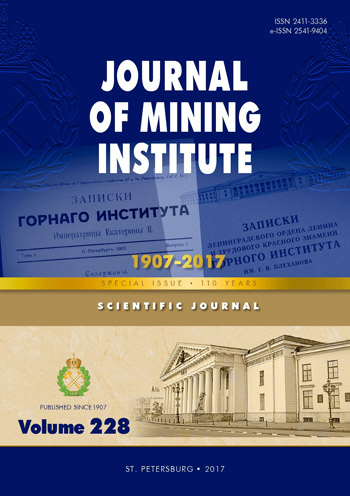Engineering-geological aspects of negative consequences of contamination of dispersive soils by petroleum products
- 1 — Ph.D., Dr.Sci. professor Saint-Petersburg Mining University
- 2 — Ph.D. assistant lecture Saint-Petersburg Mining University
Abstract
The article presents the features of transformation and migration of petroleum products in the underground environment, which are determined by the physical and physicochemical properties of petroleum hydrocarbons (density, viscosity, solubility in water, etc.) and their enclosing soils (sorption capacity, humidity, etc.). The main processes of degradation of oil products in the soil stratum are considered. The influence of oil products on the change in oxidation-reduction and acid-alkaline conditions of the underground space, development of activity of various forms of microorganisms is shown. The change in the composition and properties of dispersive soils of various degrees of water saturation is experimentally studied. The analysis of the causes of the reservoir destruction used for storage of fuel oil is given. It was established that the development of microbial activity at its base led to the transition of sands to quicksands, and moraine loams to quasi-plastic varieties. Intensive gas formation of methane and its homologues, nitrogen, carbon dioxide, hydrogen in sands was recorded. Based on the analysis of the results of long-term monitoring of the effect of contamination of dispersive soils by oil products, their bearing capacity in the base of the structures has been reduced to 50% of the initial value. The role of microbial activity in the formation of an aggressive environment in relation to building materials is shown.
References
- Eremin N.A., Ibatullin R.R., Nazina T.N., Sitnikov A.A. Biomethods for enhanced oil recovery. Мoscow: RGUneftiigazaim. I.M.Gubkina. 2003, p. 125(in Russian).
- Bunchuk V.A. Transport and storage of oil, petroleum products and gas. Мoscow: Nedra, 1977, p. 366 (in Russian).
- Germanov A.I. Oxygen of groundwater and its geochemical significance. Izvestija ANSSSR. Serija geologicheskaja. 1955. N 6, p. 70-81 (in Russian).
- Gol'dberg V.M., Gazda S. Hydrogeological principles of groundwater protection from pollution. Мoscow: Nedra,1984, p.262 (in Russian).
- Dashko R.Je., Vlasov D.Ju., Shidlovskaja A.V. Geotechnics and underground microbiota. PI «Georekonstrukcija». St. Petersburg, 2014, p. 269 (in Russian).
- Dashko R.Je., Lange I.Ju. Forecasting the change in the bearing capacity of sandy-clay soils in the process of their contamination with oil products. Zapiski Gornogo instituta. 2015. Vol. 211, p. 16-21 (in Russian).
- Zakutin V.P., Sheka V.A. Oxidation-reduction states of groundwater. Мoscow: VIJeMS, 1985, p.53(in Russian).
- Krajnov S.R., Shvec V.M. Hydrogeochemistry. Мoscow: Nedra, 1992, p. 463.
- Mironenko V.A., Petrov N.S. Pollution of groundwater by hydrocarbons. Geojekologija. 1995. N1, p. 3-27 (in Russian).
- Parfit G., Rochester K. Adsorption from solutions on surfaces of solids. Мoscow: Mir, 1986, p. 488 (in Russian).
- Perel'man A.I. Geochemistry. Мoscow: Vysshaja shkola, 1989, p. 528(in Russian).
- Konovalov P.A., Mangushev R.A., Sotnikov S.N. et al. Foundations of steel tanks and deformation of their bases. Мoscow: Izd-vo Associacii stroitel'nyh vuzov, 2009, p. 335(in Russian).
- Cegelsky L., Smith C.L., Hultgren S.J. Microbial Adhesion. Desk Encyclopedia of Microbiology. Elsevier, 2010, p. 20-28.
- Fried I.I. Groundwater pollution: theory, methodology, modeling and practical rules. Oxford – New York, 1975, p.330.
- Okolelova A.A., Kasterina N.G., Merzlyakova A.S. Determination of Oil Products in Soil by Fractions. International Journal of Environmental Problems. 2005. Vol. 1, p. 49-58.
- O ́Toole G., Kaplan H.B., Kolter R. Biofilm formation as microbial development. Annu. Rev. Microbiol. 2000. Vol. 54, p.49-79.
